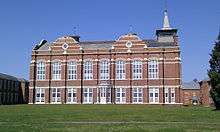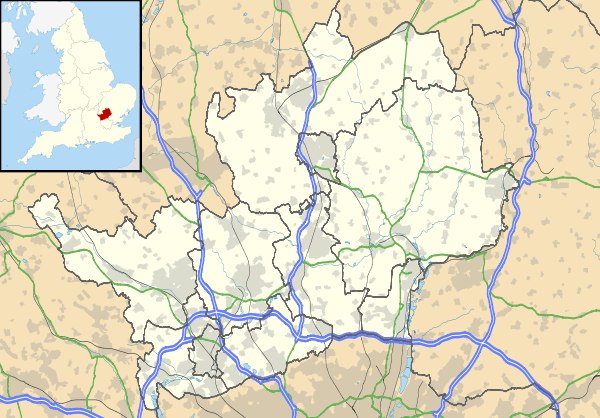Napsbury Park
Coordinates: 51°43′23″N 0°18′36″W / 51.723°N 0.310°W
Napsbury Park is a residential development in Hertfordshire, England. It is located to the north of London, at Junction 22 of the M25 motorway and Junction 6 of the M1 motorway. At the 2011 Census the population was included in the ward of St. Stephen
It is near St Albans and is part of the St Albans District. It falls within the London Colney Parish Council area. It is close to St Albans, Radlett and Potters Bar, where some residents travel to work, shop and commute to London. The 658 bus directly serves Napsbury Park and connects the estate with St Albans, London Colney, Shenley and Borehamwood. The nearby bus stop at London Colney High Street is called upon by the 602 bus which connects to St Albans, Watford, Radlett and Hatfield; And the 84 bus which connects with St Albans, Potters Bar and Barnet.
Early history
Prehistoric or Roman activity is indicated by cropmarks to the east of the railway in Napsbury hospital grounds; and again on the north side of the hospital. Documentary evidence suggests the existence of a lost medieval settlement.[1][2] Early Napsbury is mentioned in the Domesday Book, when it was called Absa and owned by Cedric, a vassall of Archbishop Stigand:[3] it had a house called Tylehouse which was associated with tile and brick workings. It is known that there were people settled there with tofts, smallholdings or farms, since tithes were payable in the 14th century.[4] The house on the Napsbury estate was later owned by Nicholas Bacon, father of Francis Bacon.[3]
Napsbury Hospital
The Middlesex County Asylum was founded in 1898 with the hospital designed in a country estate style in 1900 by architect Rowland Plumbe, who also rebuilt, to his designs, the Royal London Hospital, Whitechapel in 1897.
The hospital was designed for 1,205 residents,[5] and the grounds were designed by William Goldring.[5] Following the construction of the numerous buildings and extensive grounds, Napsbury opened on 3 June 1905.[6] According to the Middlesex County Record, the initial cost, including land and equipment, was £545,000, or £473 per bed. In 1908 Plumbe designed an extension to accommodate a further 600 patients.[7]
During the First World War, Napsbury was used for and known as the County of Middlesex War Hospital, which treated wounded soldiers.[5][8][9] Following the war, the hospital was returned to its original purpose,[3] and, in the late 1920s, a nurses' home was also added to the site.
Although Napsbury suffered some bomb damage in the Blitz, it was in continuous use as a hospital until its official closure in 1998. However, until at least 2002 one building was still in use for psychiatric patients.[5] Due to its largely untouched parkland, Napsbury was listed by English Heritage as a Grade II Historic Park and Garden in 2001.[10]
Redevelopment

After the closure of the hospital, Crest Nicholson acquired the site and built the current residential development sympathetically around the existing wood and parkland areas. Now consisting of approximately 500 residences spread over newly built detached, terraced and townhouses also apartments converted from the original buildings. Features include multi-use tennis courts, cricket and sports pitches, a sports pavilion building and footpaths throughout the extensive woodland. [11]
Local features
Napsbury railway station was built by the Midland Railway in 1905 on its line to St Pancras station. Consisting of an island platform between the slow lines, with a siding serving the Middlesex County Asylum at Napsbury, it closed in 1959.[3]
There is currently planning permission for the first commercial and retail units on the site, which will build upon the settlement's village status.[12]
Famous residents
References
- ↑ The Deserted Medieval Villages Of Hertfordshire 2nd Ed 1982- K. Rutherford Davis ISBN 0-901354-23-6
- ↑ Bourn, Rob (September 2007). "Archaeological desk based assessment" (PDF). Radlett SRFI St Albans Hertfordshire. St Albans District Council. Retrieved 25 March 2010.
- 1 2 3 4 5 Ted Banfield (1985), Remember London Colney, Barracuda Books
- ↑ Page (editor), William (1908). "British History Online". Parishes: St Peter's', A History of the County of Hertford: volume 2 (1908): "Napsbury". Victoria County History. pp. 412–424. Retrieved 25 March 2010.
- 1 2 3 4 5 Warwack, O. (2007). "A bit about Napsbury". Retrieved 2008-06-21.
- ↑ "Middlesex County Asylum". Cracknell, P. 2005. Retrieved 2008-06-21.
- ↑ "A History of Napsbury Park".
- ↑ "Napsbury". Genealogy in Hertfordshire. 2007. Retrieved 2008-06-21.
- ↑ Toms, J. (2006). "Review of Forgotten Lunatics of the Great War by Peter Barham". Institute of Historical Research. Retrieved 2008-06-21.; Bill Pollard, email to Jamie Oliver, May 8, 2011.
- ↑ Napsbury Park.com - http://www.napsburypark.com/main/
- ↑ Napsbury Park.com - http://napsburypark.com/main/index.php?option=com_content&task=view&id=27&Itemid=41
- ↑ St Albans City - www.stalbans.gov.uk
- ↑ Boden, A (2007). "Ivor Gurney : A Biographical outline". Ivor Gurney Society. Retrieved 2013-01-20.
- ↑ Dean, M (2012-08-23). "Opal Whiteley's Riddles". The New Yorker. Retrieved 2013-01-20.
